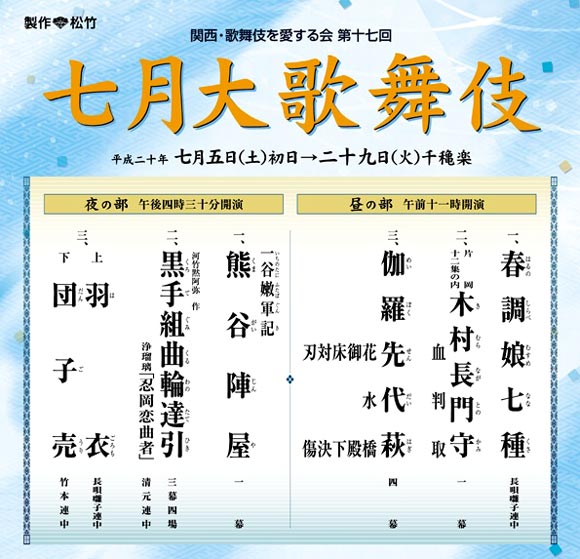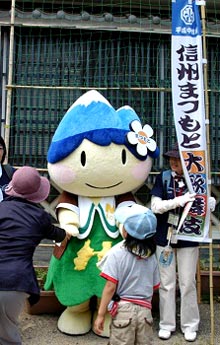| JULY 2008 |
|
4 shows in T˘ky˘ (Kabukiza, National Theatre, Nissay Theatre), 2 in ďsaka (Sh˘chikuza), 1 in Ky˘to (Enryakuji), 1 in Matsumoto (Matsumoto Performing Arts Centre) and 2 tours (Eastern Provinces, Central Provinces)!
|
| Kabukiza (T˘ky˘) |  |
| Dates | 7 ~ 31 July 2008 (Shichigatsu ďkabuki) |
| MatinÚe |
|
| Evening |
Yasha-ga-Ike K˘ya Hijiri |
| Casting |
Band˘ Tamasabur˘, Ichikawa Ebiz˘, Nakamura Karoku, Ichikawa Shun'en, Ichikawa Emisabur˘, Ichikawa Danjir˘, Ichikawa Monnosuke, Kataoka Ichiz˘ |
| Comments |
July at Kabukiza features some of the most famous acts of one of Kabuki's greatest classics "Yoshitsune Senbon Zakura", Yoshitsune and the Thousand Cherry Trees, with two of the hottest stars in Kabuki, Ichikawa Ebiz˘ and onnagata superstar Band˘ Tamasabur˘. The program also features the young stars of Ichikawa Ennosuke's troupe of actors. The evening program is a rare presentation of two plays by the fantastic writer Izumi Ky˘ka (1873~1939), including a second-time performance of a dramatization of Ky˘ka's most famous novel, "K˘ya Hijiri". He created a fantastic world of demonic gods, princesses, handsome warriors under the sea, on top of a castle tower or at the bottom of a cold mountain lake and a world of geisha and their patrons that is the heart of the repertory of the Shinpa theater. No actor knows every facet of Izumi Ky˘ka's works better than Band˘ Tamasabur˘, who has acted in his plays, directed his works on stage and in film. The evening program is a rare program of two plays by Izumi Ky˘ka. The entire program is supervised by Band˘ Tamasabur˘ who also stars in "K˘ya Hijiri".
|
| Sh˘chikuza (ďsaka) |
| Dates | 5 ~ 29 July 2008 (Shichigatsu ďkabuki) |
| MatinÚe |
Haru no Shirabe Musume Nanakusa
|
| Evening |
Ichi-no-Tani Futaba Gunki (Kumagai Jin'ya) |
| Casting |
Kataoka Nizaemon, Sakata T˘jűr˘, Onoe Kikugor˘, Kataoka Gat˘, Kataoka Hidetar˘, Nakamura Kaishun, Ichikawa Sadanji, Sawamura Tanosuke, Kataoka Ainosuke, Onoe Kikunosuke, Kataoka Takatar˘, Onoe Sh˘roku, Kataoka Shinnosuke |
| Comments |
|
 |
|
| National Theatre (T˘ky˘) |
| Dates | 3 ~ 24 July 2008 (Shichigatsu Kabuki Kansh˘ Ky˘shitsu) |
| Program |
Kabuki no Mikata |
| Casting | |
| Comments |
Educational program at the National Theatre called Kabuki Kansh˘ Ky˘shitu ("Kabuki Appreciation Class"). This is a very interesting formula for the beginners because there is lively presentation of Kabuki (or some aspects of the art like music, stage tricks or fighting scenes) on stage, followed by the drama "Shi-no-Kiri": |
| Matsumoto Performing Arts Centre (Matsumoto) | |
| Dates | 5 ~ 13 July 2008 (Shinshű Matsumoto ďkabuki) |
| Program |
|
| Casting |
Nakamura Kanzabur˘, Nakamura Hashinosuke, Nakamura Senjaku, Band˘ Yajűr˘, Nakamura Kantar˘, Nakamura Shichinosuke, Sasano Takashi |
| Comments |
The Heisei Nakamuraza troupe, led by the star Nakamura Kanzabur˘, performs for the first time in the city of Matsumoto. This exceptional program is called Shinshű Matsumoto ďkabuki (Shinshű is an old name for the province of Nagano, whose main city is Matsumoto): |
 |
|
| Kabuki Tour in the Central Provinces | |
| Dates | 30 June ~ 31 July 2008 |
| Program | |
| Casting |
Nakamura Kinnosuke, Nakamura Tokiz˘, Nakamura Baigyoku, Nakamura T˘z˘, Nakamura Matsue, Nakamura Baishi |
| Comments |
Nakamura Kinnosuke celebrates his shűmei in the Central provinces, playing the role of Rokusuke in the drama "Keya-mura".
|
| Kabuki Tour in the Eastern Provinces | |
| Dates | 30 June ~ 31 July 2008 |
| Program |
Benten Musume Meo no Shiranami
|
| Casting |
Ichikawa Danshir˘, Ichikawa Kamejir˘, Band˘ Takesabur˘, Nakamura Kikaku, ďtani Keiz˘, Band˘ Minosuke |
| Comments |
|
| Enryakuji Temple (Ky˘to) | |
| Dates | 19 ~ 25 July 2008 (Hieizan Takigi Kabuki) |
| Program |
Hiire no Gi Fujito |
| Casting |
Nakamura Kichiemon, Nakamura Shibajaku, Nakamura Kanjaku, Nakamura Fukusuke, Nakamura Kazutar˘ |
| Comments |
Original outdoors Kabuki performance, in the precincts of the famous Enryakuji temple which is located on mount Hiei. |
|
|||
| Dates | 27 ~ 29 July 2008 | ||
| Program |
Date Musume Koi no Higanoko (Yagura no Oshichi) Kabuki no Tanoshimi |
||
| Casting |
Band˘ Mitsugor˘, Nakamura Kanjaku, Onoe Ukon, Band˘ Shűch˘, Nakamura Kazutar˘ |
||
| Comments |
Short program called International Family Festival, aiming at gathering together children and parents to enjoy Kabuki. |
||
|
|
| Contact | Main | Top | Updates | Actors | Plays | Playwrights | Programs | Links | FAQ | Glossary | Chronology | Illustrations | Prints | Characters | Derivatives | Theaters | Coming soon | News |